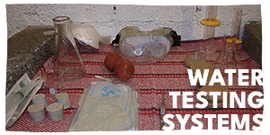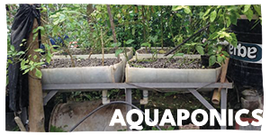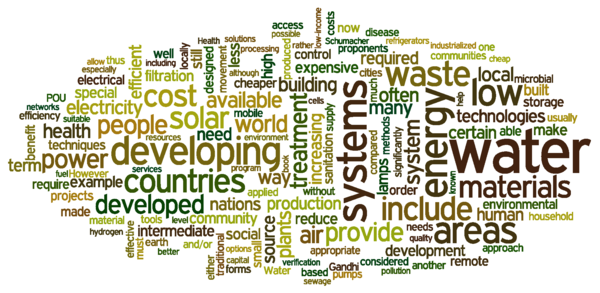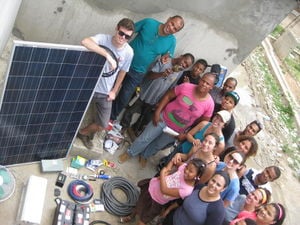
Appropriate technology (AT) is technology that is designed to be "appropriate" to the context it is intended for - including environmentally, culturally and economically.
The main characteristics of most ATs are that they should be sustainable, small and appropriate. To be effective in practice, it should be easy to maintain. To be effective for many people and have a wide impact, it must be affordable.
It can also be described as the simplest level of technology that can effectively achieve the intended purpose in a given location. In developed countries, the term appropriate technology takes a different meaning, often referring to engineering that takes special consideration of its social and environmental ramifications.[1]
Some prefer to capitalize the term as Appropriate Technology, to distinguish it from other situations where the words "appropriate technology" might be chosen. Synonyms are intermediate technology, simple technologies and technologies for the poor.
On Appropedia[edit | edit source]
There are hundreds of pages related to appropriate technology on Appropedia. Here are a few selected examples:
Principles[edit | edit source]

What makes appropriate technology is determined by context. Therefore, none of these are absolute — they are simply common features that make a technology "appropriate" to a world where many suffer a lack of basic necessities, a lack of money, and lack of equipment and technological expertise.
- Small (as in Small is Beautiful) — Small often means affordable and adaptable, and puts the control in the hands of the users. Small also means local, which offers benefits in resilience. This places more power at the grassroots, in the hands of the users. However, there are also times when the most appropriate technologies are large-scale.
- Few moving parts — Less to go wrong (similar to the KISS principle,W and the "durable, efficient, stoic" principle).
- Can be built locally
- Made with locally available materials
- Easily repaired — By local people with locally available equipment.
- Affordable
- Suitably disposable — Locally and not polluting in it's disposal or recycling
Features such as low cost, low usage of fossil fuels and use of locally available resources are advantages in sustainability. For that reason, these technologies are sometimes used and promoted by advocates of sustainability and alternative technology. They are also technologies that have a gentle impact on the environment.
The source of the technology doesn't matter much. It matters much more that it is appropriate. While the source of a technology sometimes becomes an issue in discussions of technology for international development, technology from anywhere can have uptake and make an impact, as evidenced by the mobile phone.
More generally, appropriate technology is appropriate to the context, including the environmental, ethical, cultural, social, political, and economical context. The appropriate technology for one context may not be appropriate for another. Appropriate technology is also sustainable, requiring fewer natural resources and producing less pollution than techniques from mainstream technology, which are often wasteful and environmentally polluting.[2] In addition, or in envisioning a future phase of AT that lies on a more subjectively-observed axis of knowing, proponents could also claim their methods make more life(-energy) sense, are more at balance or in harmony with the natural environment, and enable appropriate, healthier, happier, more fulfilling, meaningful or purposeful ways of life.
Contexts[edit | edit source]
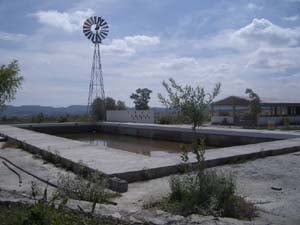
Although the term appropriate technology is used wherever individuals or small communities wish to lower their environmental impact and increase their resilience, is typically used in these two contexts:
- Socially and environmentally acceptable technologies in industrialized nations.
- The most effective technology to address the needs of developing nations or less developed rural areas of industrialized nations.[3]
When the technologies are applied in developed countries, it is often for the purpose of either going off the grid, or at least becoming less dependent on it. This form of "appropriate technology" usually prefers labor-intensive solutions over capital-intensive ones,[verification needed] although labor-saving devices are also valuable, provided this does not mean high capital, maintenance cost or environmental impact.
In poorer or remote areas, the starting point is often a lack of a "grid" - i.e. a lack of infrastructure such as electricity, piped water and sewerage. Where the target is the poor, the greatest impact comes where massive scale-up occurs through an appealing, cost-effective product. The "bottom of the pyramid" can pay for technology if the price is right, and this allows for much greater scale than subsidized programs, and is likely to be more appealing than DIY approaches that require a particular skill-set.
History[edit | edit source]

Gandhi: self-reliance[edit | edit source]
Mohandas GandhiW (known as Mahatma Gandhi) advocated small, local, mostly village-based technology to help India's villages become self reliant, resisting the dependence associated with colonialism, to aid in the freedom struggle against British and wealthy Indians.
Gandhi promoted the philosophy of "swadeshi" or self-reliance. He did not believe that technological development was inherently synonymous with progress. He believed the powers of technology should be produced and used artfully and the benefits should be close to the individual and widely produced and distributed in a decentralised fashion. Gandhi stated that his favorite technologies were the sewing machine, because it was invented out of love, and the bicycle, because it kept one's feet close to the ground. He felt that technology should not disenfranchises people or be used for violence - rather that it should be used to empower people broadly. The movement for self-rule was based on local economies, and Gandhi championed the spinning wheel, or charka, employed in the khadi movement in the 1920s, which produced cloth locally in an act of civil disobedience, causing the British monopoly on textiles to collapse. The spinning wheel is today seen at the center of the Indian national flag,W and the flag itself must, by law, be made of khadi.
In the movement for SwarajW (home rule), Gandhi believed in a revolution of production, saying "It is not about getting rid of the tiger and keeping the tiger's nature". Saying "it is better for a machine to be idle than a man to be idle", Gandhi rejected the factory model of industrialization. He raised money to offer a reward for someone to invent a spinning wheel that could employ people in the same way, while producing more thread.
Schumacher: Small is Beautiful[edit | edit source]
E. F. "Fritz" Schumacher was an economist who acted as an advisor to governments. The concept of intermediate technology, or appropriate technology, was promoted by E. F. Schumacher from the 1950's through the 1970's,[4] culminating in the publication of his book Small is Beautiful.
He was strongly influenced by Gandhi's philosophy, and took Gandhi's village development ideas further, coining the term "intermediate technology". Through his book Small is Beautiful[5] and later by creating the Intermediate Technology Development Group (now Practical Action), he pioneered appropriate technology in development work.
Schumacher's term intermediate technology is similar to appropriate technology. It refers to tools and technology that are significantly more effective than traditional methods, but still an order of magnitude (one tenth) cheaper than developed world technology. Such items are generally within the economic reach of poor people, and according to proponents can lead to greater productivity with minimal social dislocation. Intermediate technology can also be built and serviced largely using locally available materials and knowledge, with minimal input from outside. This is conducive to decentralization, compatible with ecology, gentle in its use of scarce resources, and designed to serve humans and avoid making them the servants of machines.
In Small is Beautiful, Schumacher also proposed "Buddhist Economics," which "tries to maximize human satisfactions by the optimal pattern of consumption," as opposed to mainstream Western economics, which "tries to maximize consumption".
Further reading:
- Who Was Fritz Schumacher? by Diana Schumacher, November 25, 2011, gandhifoundation.org
Papanek: Design for Human Scale[edit | edit source]
Victor PapanekW wrote about similar concepts in the context of design of everyday products. His writing is full of examples of appropriate and inappropriate designs (without necessarily using those terms) and are an inspiring introduction to design.
Papanek's books include
- Design for the Real World
- Design for Human Scale
Albertson and Faulkner: Appropriate hard and soft technologies[edit | edit source]
According to Dr. Maurice AlbertsonW and Faulkner, appropriate hard technology is "engineering techniques, physical structures, and machinery that meet a need defined by a community, and utilize the material at hand or readily available. It can be built, operated and maintained by the local people with very limited outside assistance (e.g., technical, material, or financial). it is usually related to an economic goal." Some have explored the use of classroom projects for university-level physics students to research, develop and test appropriate hard technology.[6]
Albertson and Faulkner consider "appropriate soft technology" as technology that deals with "the social structures, human interactive processes, and motivation techniques. It is the structure and process for social participation and action by individuals and groups in analyzing situations, making choices and engaging in choice-implementing behaviors that bring about change."[7]
The Water Decade: Village-level operation and maintenance[edit | edit source]
Water pumps came to demonstrate the importance of appropriateness and context in the application of technology.
During the International Drinking Water Decade (1981-1990),W water wells with pumps were provided to villages in developing countries around the world, paid for primarily with foreign aid. This tended to be done in a top-down manner, with little attention to the local context. While claims are made for great strides in access to water, counter-claims are made that many of the water pump projects failed.
A key problem was that the pumps were difficult to maintain at the village level - parts were not easily accessible or repairable, and/or specialized skills were required that did not exist in the typical village. After the water decade, "village-level operation and maintenance" pumps, or VLOM pumps, were introduced. Such an approach reduces the dependency of villages on governments and donors.
This lesson - the ability to maintain equipment locally - continues to be re-learned in many aid and development projects, decades on. The above concern about maintaining hand pumps is still true. There are now VERY low cost 12v pumps that should be considered!
Paul Polak: The Death of Appropriate Technology organizations[edit | edit source]
More recently, Paul Polak stated that the flowering of the Appropriate Technology movement in decades past had no major impact on the poor, and many organizations devoted to appropriate technology have closed or scaled-down.
He provocatively argues that the production of "appropriate technology" has died as the organizations producing appropriate technology did not apply business models with an emphasis on financial viability.
In two blog posts on "The Death of Appropriate Technology" he states:
The appropriate technology movement died because it was led by well-intentioned tinkerers instead of hard-nosed entrepreneurs designing for the market.
His arguments are found at:
- The Death of Appropriate Technology I: If you can't sell it don't do it
- The Death of Appropriate Technology II: How to Design for the Market
He talks about technology for the poor, as distinct from the earlier appropriate technology movement which he argues did not take cost-effectiveness seriously, and therefore failed. However, initiatives such as Gunter Pauli's Blue Economy project W and products made by commercial companies (ie Tata Motors' Tata Nano,...) seem to show that there are still companies that do successfully marry low-cost design with keen business insight.
Appropedia: appropriate technology goes online[edit | edit source]
A new stage in appropriate technology has come with the introduction of the internet. The internet has facilitated the sharing of designs by AT organizations. These designs were already open design, yet the sharing of the designs happened at too small a scale in the past. Designs of several devices/objects are now being shared across the internet using sites as Appropedia, Instructables, Permies... and reach people even outside the AT sector. In addition, kits and manuals sold by various organizations are now also being shared and help the poor in constructing complex, low-cost objects. The use of the Internet combined with digital technology enables people to learn about and apply the principles of appropriate technology at home.
Other practitioners and advocates[edit | edit source]
Well known advocates and practitioners of appropriate technology include:
- Paul Polak
- Buckminster Fuller
- Paul Wheaton
- Amory LovinsW
- B.V. DoshiW[8]
- M.K. Ghosh[9]
- Arne NæssW (1912–2009)
- William MoyerW (1933–2002)
- John BarrieW
- Sanoussi DiakitéW
- Johan Van LengenW
- Amy Smith
See also[edit | edit source]
- A Guide for the Perplexed
- Alternative technology
- Appropedia:About
- Community-based economics
- Cradle-to-cradle design
- Campus Center for Appropriate Technology (CCAT)
- Do-It-Yourself (DIY)
- Ecovillages
- E. F. Schumacher on appropriate technology
- Permaculture
- Practical Action (charity formerly known as Intermediate Technology Development Group)
- Small Is Beautiful
External links[edit | edit source]
- Wikipedia:Appropriate technology
- Wikipedia:Appropriate technology Africa
- Wikiversity:Topic:Self-sufficiency
- Wikiversity:Environmental community building
- Wikiversity:Appropriate technology designs
- International Journal for Service Learning in Engineering (IJSLE) - Peer-reviewed, semi-annual online journal, covering appropriate and sustainable technologies and related areas.
- GrAT - Center for Appropriate Technology - GrAT is a scientific association for research and development of Appropriate Technology in Vienna, Austria.
- AproveEcho - An environmental education center with a focus on living with appropriate technologies.
- Low tech forums at Permies.com
- Sustainable Energy forums at Permies.com
- Natural and off-grid building forums at Permies.com
- 177 hours of video: the Permaculture Design Course and Appropriate Technology Courseat Permies.com
- Permaculture Technology Jamboree at Wheaton Labs
Further readings[edit | edit source]
- Basic Needs Approach, Appropriate Technology, and Institutionalism. Journal of Economic Issues, (1988), 22(2), 363-370. DOI:10.1080/00213624.1988.11504765
- Environmentally-appropriate technology under lack of resources and knowledge: Solar-powered cocoa dryer in rural Nias, Indonesia. Cleaner Engineering and Technology, (2022), 8, 100494. DOI:10.1016/j.clet.2022.100494
- Technological appropriateness of biomass production in rural settings: Addressing water hyacinths (E. crassipes) problem in Lake Tondano, Indonesia. Technology in Society, (2021), 66, 101658. DOI:10.1016/j.techsoc.2021.101658
- Design and technological appropriateness: The quest for community survivability. Journal of Sustainability Science and Management, (2014), 9(1), 1-17. DOI:10.46754/jssm.2014.06.001
- Quantitative assessment of Appropriate Technology. Procedia Engineering, (2014), 78, 345-358. DOI:10.1016/j.proeng.2014.07.076
- Environmental forensics on Appropriate-Technology-enhanced supply chain of rural commodities. In A.Z. Aris et al. (eds), (2014), From Sources to Solutions, ch. 11, pp. 55-60. Singapore: Springer. DOI:10.1007/978-981-4560-70-2_11
- Design methodology for Appropriate Technology: Engineering as if people mattered. Sustainability, (2013), 5(8), 3382-3425. DOI:10.3390/su5083382. NOTE: Featured by Engineering for Change (E4C).
- Seven pillars of survivability: Appropriate Technology with a human face. European Journal of Sustainable Development, (2013), 2(4), 1-18. DOI:10.14207/ejsd.2013.v2n4p1
References[edit | edit source]
- ↑ Schneider, Keith. "Majoring in Renewable Energy." 26 March 2008.
- ↑ Appropriate Technology Sourcebook: Introduction at VillageEarth.org. Accessed on 5 July 2008.
- ↑ Appropriate Technology Sourcebook: Introduction on VillageEarth.org, accessed on 5 July 2008.
- ↑ E. F. Schumacher: Changing the Paradigm of Bigger Is Better, Roli Varma, 2003.
- ↑ Schumacher, E. F.; Small Is Beautiful: Economics As If People Mattered: 25 Years Later...With Commentaries. Hartley & Marks Publishers ISBN 0-88179-169-5
- ↑ Joshua M. Pearce, "Teaching Physics Using Appropriate Technology Projects", The Physics Teacher, 45, pp. 164-167, 2007. open access
- ↑ Faulkner, A. O. and M. L. Albertson. "Tandem use of Hard and Soft Technology: an Evolving Model for Third World Village Development" International Journal of Applied Engineering Education. Vol. 2, No. 2 pp 127-137, 1986.
- ↑ see http://www.indiaenvironmentportal.org.in/node/5799/ and BV Doshi as AT founder
- ↑ http://www.indiaenvironmentportal.org.in/node/5799/







